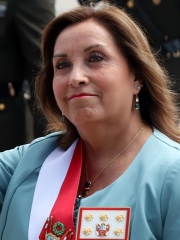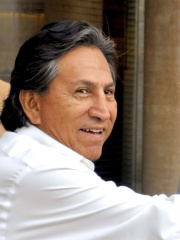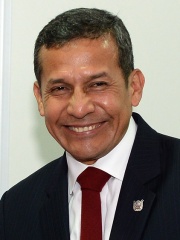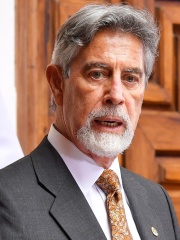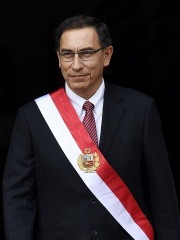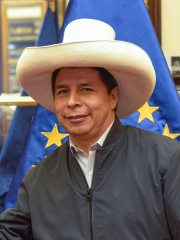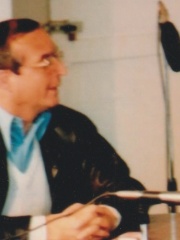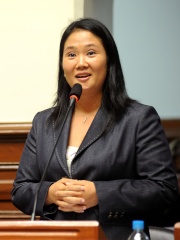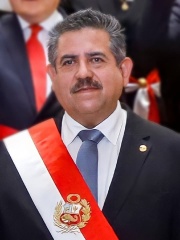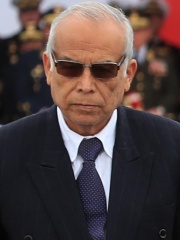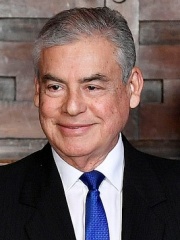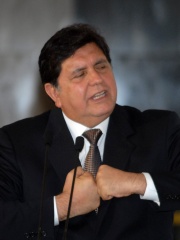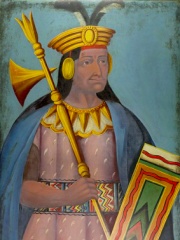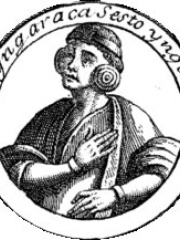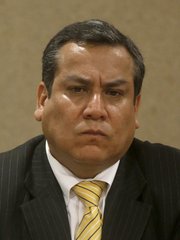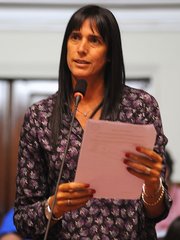
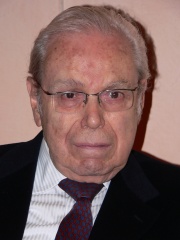
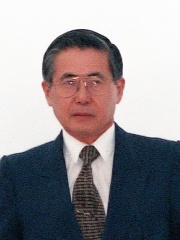
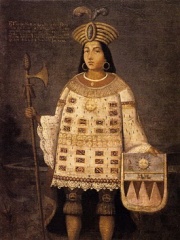
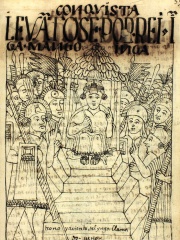
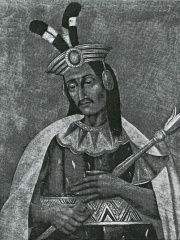
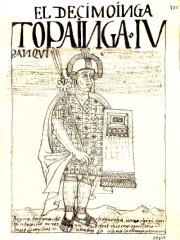
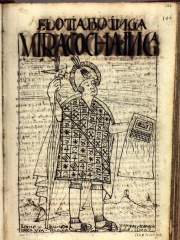
The Most Famous
POLITICIANS from Peru
This page contains a list of the greatest Peruvian Politicians. The pantheon dataset contains 19,576 Politicians, 96 of which were born in Peru. This makes Peru the birth place of the 41st most number of Politicians behind Syria, and Argentina.
Top 10
The following people are considered by Pantheon to be the top 10 most legendary Peruvian Politicians of all time. This list of famous Peruvian Politicians is sorted by HPI (Historical Popularity Index), a metric that aggregates information on a biography's online popularity. Visit the rankings page to view the entire list of Peruvian Politicians.

1. Atahualpa (1502 - 1533)
With an HPI of 78.46, Atahualpa is the most famous Peruvian Politician. His biography has been translated into 68 different languages on wikipedia.
Atahualpa ( ), also Atawallpa or Ataw Wallpa (Classical Quechua: Ataw Wallpa, pronounced [ˈataw ˈwaʎpa]) (c. 1502 – 26 July 1533), whose regnal name was Caccha Pachacuti Inca Yupanqui Inca (from the caccha idol and to honour the emperor Pachacuti), was the last effective Inca emperor, reigning from April 1532 until his capture and execution in July of the following year, as part of the Spanish conquest of the Inca Empire.

2. Javier Pérez de Cuéllar (1920 - 2020)
With an HPI of 75.90, Javier Pérez de Cuéllar is the 2nd most famous Peruvian Politician. His biography has been translated into 77 different languages.
Javier Felipe Ricardo Pérez de Cuéllar Guerra ( PERR-ess də KWAY-yar, Spanish: [xaˈβjeɾ ˈpeɾes ðe ˈkweʝaɾ]; 19 January 1920 – 4 March 2020) was a Peruvian diplomat and politician who served as the fifth secretary-general of the United Nations from 1982 to 1991. He later served as prime minister of Peru from 2000 to 2001. His two terms as secretary-general coincided with the final decade of the Cold War, and he engaged in efforts to address the Iran–Iraq War, the Western Sahara conflict, the Cyprus problem, Namibian independence under the Tripartite Accord, the Soviet withdrawal from Afghanistan, the Gulf War, and the opening of the Croatian War of Independence. Pérez de Cuéllar was a member of the Club of Madrid, a group of former heads of state and government, and the Inter-American Dialogue.

3. Alberto Fujimori (1938 - 2024)
With an HPI of 75.53, Alberto Fujimori is the 3rd most famous Peruvian Politician. His biography has been translated into 78 different languages.
Alberto Kenya Fujimori Inomoto (26 July 1938 – 11 September 2024) was a Peruvian politician, professor, and engineer who served as the 54th president of Peru from 1990 to 2000. Born in Lima, Fujimori was the country's first president of Japanese descent, and was an agronomist and university rector prior to entering politics. Fujimori emerged as a politician during the midst of the internal conflict in Peru, the Peruvian Lost Decade, and the ensuing violence caused by the far-left guerilla group Shining Path. In office as president, Fujimori implemented a series of military reforms and responded to Shining Path with repressive and lethal force, halting the group's actions. He became known for his neoliberal political and economic ideology of Fujimorism, which pushed a free market economy and social conservatism. His administration was also controversial for alleged abuses of human rights and authoritarian tendencies. In 1992, during his first presidential term, Fujimori, with the support of the National Intelligence Service and the Peruvian Armed Forces, adopted Plan Verde and carried out a self-coup against the Peruvian legislature and judiciary. Fujimori dissolved the Peruvian Congress and Supreme Court, effectively making him a dictator of Peru. The coup was criticized by Peruvian politicians, intellectuals and journalists, but was well received by the country's private business sector and a substantial part of the public. Following the coup d'état, Fujimori drafted a new constitution in 1993, which was approved in a referendum, and was elected as president for a second term in 1995 and controversially for a third term in 2000. Fujimori's time in office was marked by severe authoritarian measures, excessive use of propaganda, entrenched political corruption, multiple cases of extrajudicial killings, and human rights violations. Under the provisions of Plan Verde, Fujimori targeted members of Peru's indigenous community and subjected them to forced sterilizations. In 2000, following his third term election, Fujimori faced mounting allegations of widespread corruption and crimes against humanity within his government. Subsequently, Fujimori fled to Japan, where he submitted his presidential resignation via fax. Peru's congress refused to accept his resignation, instead voting to remove him from office on the grounds that he was "permanently morally disabled". While he was in Japan, Peru issued multiple criminal charges against him, stemming from the corruption and human rights abuses that occurred during his government. Peru requested Fujimori's extradition from Japan, which was refused by the Japanese government due to Fujimori being a Japanese citizen, and Japanese laws stipulating against extraditing its citizens. In 2005, while Fujimori was visiting Santiago, Chile, he was arrested by the Carabineros de Chile at the request of Peru, and extradited to Lima to face charges in 2007. Fujimori was sentenced to 25 years in prison, but was pardoned by president Pedro Pablo Kuczynski in 2017, and was officially released in December 2023 following several years of legal proceedings regarding the legality of his pardon. He died nine months after his release in September 2024.

4. Túpac Amaru (1545 - 1572)
With an HPI of 73.46, Túpac Amaru is the 4th most famous Peruvian Politician. His biography has been translated into 38 different languages.
Túpac Amaru or Thupa Amaru (14 April 1545 – 24 September 1572) (first name also spelled Túpac, Tupac, Topa, Tupaq, Thupaq, Thupa, last name also spelled Amaro instead of Amaru) was the last Sapa Inca of the Neo-Inca State, the final remaining independent part of the Inca Empire. He was executed by the Spanish following a months-long pursuit after the fall of the Neo-Inca State. His name is derived from the Quechua words thupaq, meaning "royal" or "shining" and amaru, which can either mean "snake" or refer to the snake-like being from Andean mythology.
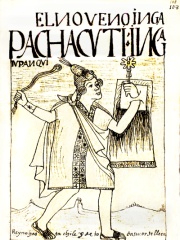
5. Pachacuti (1380 - 1460)
With an HPI of 73.45, Pachacuti is the 5th most famous Peruvian Politician. His biography has been translated into 45 different languages.
Pachacuti Inca Yupanqui, also called Pachacútec (Quechua: Pachakutiy Inka Yupanki, pronounced [ˈpatʃa ˈkuti ˈiŋka juˈpaŋki]), was the ninth Sapa Inca of the Chiefdom of Cusco, which he transformed into the Inca Empire (Tawantinsuyu). Most archaeologists now believe that the famous Inca site of Machu Picchu was built as an estate for Pachacuti. In Quechua, the cosmogonical concept of pachakutiy means "the turn of the world" and yupanki could mean "honorable lord". During his reign, Cusco grew from a hamlet into an empire that could compete with, and eventually overtake, the Chimú empire on the northern coast. He began an era of conquest that, within three generations, expanded the Inca dominion from the valley of Cusco to a sizeable part of western South America. According to the Inca chronicler Garcilaso de la Vega, Pachacuti created the Inti Raymi to celebrate the new year in the Andes of the southern hemisphere. Pachacuti is often linked to the origin and expansion of the cult of Inti. Following his death, Pachacuti's deeds were transmitted through various means, including genealogical histories, life histories, and quipus, kept near his royal mummy. Accessing power following the Chanka–Inca War, Pachacuti conquered territories around Lake Titicaca and Lake Poopó in the south, parts of the eastern slopes of the Andes Mountains near the Amazon rainforest in the east, lands up to the Quito basin in the north, and lands from Tumbes to possibly the coastal regions from Nasca and Camaná to Tarapacá. These conquests were achieved with the help of many military commanders, and they initiated Inca imperial expansion in the Andes. Pachacuti is considered by some anthropologists to be one of the first historical emperors of the Incas, and by others to be a mythological and cosmological representation of the beginning of the era of Inca imperial expansion.

6. Manco Inca Yupanqui (1512 - 1544)
With an HPI of 70.79, Manco Inca Yupanqui is the 6th most famous Peruvian Politician. His biography has been translated into 33 different languages.
Manco Inca Yupanqui (c. 1515 – 1544) was the founder and first Sapa Inca of the independent Neo-Inca State in Vilcabamba, although he was originally a puppet Inca Emperor installed by the Spaniards. He was also known as Manco II and Manco Cápac II. He was one of the sons of Huayna Cápac and a younger brother of Huáscar.

7. Huáscar (1490 - 1533)
With an HPI of 70.20, Huáscar is the 7th most famous Peruvian Politician. His biography has been translated into 37 different languages.
Huáscar () (Classical Quechua: Waskhar, pronounced [waskʰar]) also Guazcar (before 1527 – 1532) was Sapa Inca of the Inca Empire from 1527 to 1532. He succeeded his father, Huayna Capac and his brother Ninan Cuyochi, both of whom died of smallpox during the same year while campaigning near Quito.

8. Topa Inca Yupanqui (1441 - 1493)
With an HPI of 69.72, Topa Inca Yupanqui is the 8th most famous Peruvian Politician. His biography has been translated into 33 different languages.
Topa Inca Yupanqui or Túpac Inca Yupanqui (Cusco Quechua: Thupa Inka Yupanki, pronounced [ˈtʰupa ˈiŋka juˈpaŋki]), also Topa Inga Yupangui, erroneously translated as "noble Inca accountant" (before 1471 – 1493) was the tenth Sapa Inca (1471–1493) of the Inca Empire, fifth of the Hanan dynasty. His father was Pachacuti, and his son was Huayna Capac. Topa Inca belonged to the Qhapaq Panaca (one of the clans of Inca nobles). His quya (principal wife) was his older sister, Mama Ocllo.

9. Viracocha Inca (1310 - 1438)
With an HPI of 68.30, Viracocha Inca is the 9th most famous Peruvian Politician. His biography has been translated into 31 different languages.
Viracocha Inca (Quechua, the name of a god) or Viracocha (in hispanicized spelling) (c. 1410 – 1438) was the eighth Sapa Inka of the Kingdom of Cuzco (beginning around 1410) and the third of the Hanan dynasty.
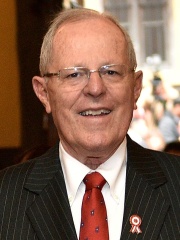
10. Pedro Pablo Kuczynski (b. 1938)
With an HPI of 67.66, Pedro Pablo Kuczynski is the 10th most famous Peruvian Politician. His biography has been translated into 50 different languages.
Pedro Pablo Kuczynski Godard (Latin American Spanish: [ˌpedɾo ˌpablo kuˌtʃinski‿ɣoˈðaɾð]; born 3 October 1938), also known simply as PPK (Spanish: [pepeˈka]), is a Peruvian economist, public administrator, and former politician who served as the president of Peru from 2016 to 2018. He served as prime minister of Peru and as minister of economy and finance during the presidency of Alejandro Toledo. Kuczynski resigned from the presidency on 23 March 2018, following a successful impeachment vote and days before a probable conviction vote. Since 10 April 2019 he has been in pretrial detention, due to an ongoing investigation on corruption, money laundering, and connections to Odebrecht, a public works company accused of paying bribes. Pedro Pablo Kuczynski was born in the Miraflores District of Lima to parents who fled from Germany after the Nazis came to power. Kuczynski worked in the United States before entering Peruvian politics. He held positions at both the World Bank and the International Monetary Fund before being designated the general manager of Peru's Central Reserve Bank. He later served as Minister of Energy and Mines in the early 1980s under President Fernando Belaúnde Terry, and as Minister of Economy and Finance and prime minister under President Alejandro Toledo in the 2000s. Kuczynski was a presidential candidate in the 2011 presidential election, placing third. For the 5 June 2011 runoff election, Kuczynski supported right-winger Keiko Fujimori over leftist Ollanta Humala, but Humala was elected nonetheless. Kuczynski went on to stand in the 2016 election, where he narrowly defeated Fujimori in the second round. He was sworn in as president on 28 July 2016. On 15 December 2017, the Congress of Peru, which was controlled by the opposition Popular Force, initiated impeachment proceedings against Kuczynski, after he was accused of lying about receiving payments from the scandal-hit Brazilian construction firm Odebrecht in the mid-2000s. However, on 21 December 2017, the Peruvian Congress lacked the majority of votes needed to impeach Kuczynski. After further scandals and facing a second impeachment vote, Kuczynski resigned from the presidency on 21 March 2018 following the release of videos showing alleged acts of vote buying, presenting his resignation to the Council of Ministers. He was succeeded as president by his First Vice President Martín Vizcarra. On 28 April 2019, Kuczynski was placed under house arrest while under investigation for allegedly taking bribes from Odebrecht.
People
Pantheon has 96 people classified as Peruvian politicians born between 1260 and 1990. Of these 96, 34 (35.42%) of them are still alive today. The most famous living Peruvian politicians include Pedro Pablo Kuczynski, Dina Boluarte, and Alejandro Toledo. The most famous deceased Peruvian politicians include Atahualpa, Javier Pérez de Cuéllar, and Alberto Fujimori. As of April 2024, 2 new Peruvian politicians have been added to Pantheon including Gustavo Adrianzén, and Gabriela Pérez del Solar.
Living Peruvian Politicians
Go to all RankingsPedro Pablo Kuczynski
1938 - Present
HPI: 67.66
Dina Boluarte
1962 - Present
HPI: 65.58
Alejandro Toledo
1946 - Present
HPI: 64.99
Ollanta Humala
1962 - Present
HPI: 62.53
Francisco Sagasti
1944 - Present
HPI: 61.82
Martín Vizcarra
1963 - Present
HPI: 58.86
Pedro Castillo
1969 - Present
HPI: 58.77
Vladimiro Montesinos
1945 - Present
HPI: 58.28
Keiko Fujimori
1975 - Present
HPI: 56.53
Manuel Merino
1961 - Present
HPI: 55.89
Aníbal Torres
1942 - Present
HPI: 54.14
César Villanueva
1946 - Present
HPI: 52.74
Deceased Peruvian Politicians
Go to all RankingsAtahualpa
1502 - 1533
HPI: 78.46
Javier Pérez de Cuéllar
1920 - 2020
HPI: 75.90
Alberto Fujimori
1938 - 2024
HPI: 75.53
Túpac Amaru
1545 - 1572
HPI: 73.46
Pachacuti
1380 - 1460
HPI: 73.45
Manco Inca Yupanqui
1512 - 1544
HPI: 70.79
Huáscar
1490 - 1533
HPI: 70.20
Topa Inca Yupanqui
1441 - 1493
HPI: 69.72
Viracocha Inca
1310 - 1438
HPI: 68.30
Alan García
1949 - 2019
HPI: 67.47
Túpac Huallpa
1510 - 1533
HPI: 67.16
Inca Roca
1350 - 1380
HPI: 65.33
Newly Added Peruvian Politicians (2025)
Go to all RankingsOverlapping Lives
Which Politicians were alive at the same time? This visualization shows the lifespans of the 25 most globally memorable Politicians since 1700.

